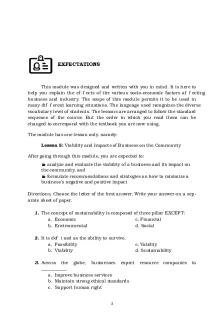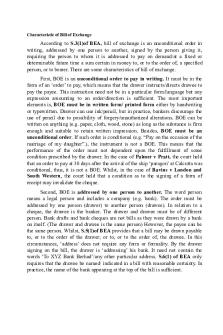Impacts of Exchange PDF

| Title | Impacts of Exchange |
|---|---|
| Course | Survey of World History |
| Institution | Western Governors University |
| Pages | 3 |
| File Size | 67.5 KB |
| File Type | |
| Total Downloads | 32 |
| Total Views | 141 |
Summary
Covers the impacts of the Columbian Exchange in the Americas, Africa, and Europe...
Description
Impacts of Exchange
Immediate effects of the Columbian Exchange are easily identified and also generated long-term consequences and ripple effects
Societies' reactions and responses to new global world system they inhabited reveal the real impact and significance to overarching narrative of the human experience in the modern period After the 15th century, few parts of the world remained untouched and unchanged by the 'discovery' of the New World on biological, economic, and sociocultural levels
New accounts of the New World and its peoples generated curiosity, but also required Europeans to incorporate them into their existing worldviews
Commodities and Nutrition: New food crops that made their way to Europe, Africa, and Asia via the Columbian Exchange offered flexibility and options to their populations
Multiple crops offered greater opportunities for surplus and exchange and provided further barriers to death and famine, but calorie-dense staples like maize and potatoes contributed to overall health and encouraged rapid population growth
In Europe and China, for example, population booms drove movements of urbanization as well as colonizing frontiers
In parts of Africa, population growth offset or exceeded the depredations of the slave trade Within 300 years of Columbus's voyages, the world population doubled Crops such as sugar, tobacco, and cotton generated new demand and patterns of consumption, stimulating new economies and networks as well as influencing labor and migration, notably in the expansion of African slavery Most immediate economic impact was silver and gold mined in the New World which supplemented diminishing supplies of bullion moving in the established world system
Almost 80% of this supply went across the Pacific, circulating throughout Asian and Indian ocean networks of exchange
Only about 10-15% of the product made it to Spain, and only half of that amount remained there Spanish Crown claimed these large amounts for ornamentation, filling the treasury, and funding warfare Domestic and international trade increased because of new connections and new cash, but inflation came along with it
Influx of large sums of currency devalued markets and nations; within a decade of the discovery of the Potosi silver mines, observers noted the declining value of silver and the corresponding rise in basic prices in Europe and elsewhere Extension of new commercial networks brought more people into new economic relationships around the globe, and new social structures emerged out of these shifts
Kenneth Pomeranz (2000) argues that on the eve of Columbus's discovery of the New World, Europe's power and wealth were marginal, and an equilibrium existed in the Gunpowder Empires of Eurasia
Impacts of Exchange
After 1492, Europe's position on the Atlantic allowed European states to dominate the new routes and networks of the Columbian Exchange, and the resources of the New World created rapid advances in financing, production, and social structures
Permanently shifted the balance in favor of Europe and laid foundations for further empire building and industrialization In the New World itself, long-term impacts of the Columbian Exchange were exemplified in the complex nature of the new colonial societies that emerged in the 16th and 17th centuries
These colonies changed the geography and ecology across much of the New World because agriculture, mining, and manufacturing grew alongside settlements and plantations
Had names and architecture that mirrored their Old World origins, but as more people made their way across the Atlantic, they brought their own histories, techniques, and ideas
Led to development of serious challenges of identity and authority Early debates over biological/spiritual nature of Native Americans emerged and generated strands of social and theological debate Church also established its authority in the New World, but new strands of theology and practice emerged along colonists
Native Christians synthesized their new Christian beliefs with traditional practices, and African slave communities created a number of syncretic/hybrid belief systems
New Worlds, New Worldviews: in 1503, a series of laws attempted to define and structure this relationship in the Americas by establishing encomiendas: land grants that provided Spanish landowners with Native American slave labor without identifying it as such and mandated their housing, provisions, and work conditions
Though the New World promised wealth and social mobility, tensions persisted between descendants of conquistadores and new immigrants, landowners and townspeople, and aristocrats and commoners
European-born settlers only accounted for approximately 1-2% of the population in the Americas, but they considered themselves superior and clashed with those who were born in the Americas Racial identities further divided colonial societies: metis, mestizo, mulatoo, and zambo came to denote people with mixed European, Native American, and African blood, which usually determined social status
Labeling stood in contrast to later colonies in North America, where native populations were smaller and settlers arrived as families, resulting in more homogenous settlements that resembled their home countries Highly organized and bureaucratic social governments operated closely with the Catholic Church, but as numbers of settlers increased, so did the challenges of integrating them into colonies
Impacts of Exchange
In Europe, the flood of information and experience raised questions of identity and purpose; debates over souls and futures of Native Americans and Africans opened issues of nation, race, sovereignty, and faith
Maps and books and shopping lists were added to and filled up, and new species and natural phenomenon were observed, but these all raised new questions about the order and hierarchy of the Christian universe and even God's divine will and plan...
Similar Free PDFs

Impacts of Exchange
- 3 Pages

Impacts of WW - aaa
- 1 Pages

Impacts of Suburbanisation
- 1 Pages

Stock Exchange of Mauritius
- 15 Pages

Impacts of Major/Mega Events
- 6 Pages

Viability and Impacts of Business
- 12 Pages

Foreign- Exchange
- 3 Pages

Gas Exchange
- 11 Pages

ION EXCHANGE
- 18 Pages

Ch31 Impacts - Government Borrowing
- 18 Pages

Bills OF Exchange ACT, 1961 (ACT 55)
- 22 Pages
Popular Institutions
- Tinajero National High School - Annex
- Politeknik Caltex Riau
- Yokohama City University
- SGT University
- University of Al-Qadisiyah
- Divine Word College of Vigan
- Techniek College Rotterdam
- Universidade de Santiago
- Universiti Teknologi MARA Cawangan Johor Kampus Pasir Gudang
- Poltekkes Kemenkes Yogyakarta
- Baguio City National High School
- Colegio san marcos
- preparatoria uno
- Centro de Bachillerato Tecnológico Industrial y de Servicios No. 107
- Dalian Maritime University
- Quang Trung Secondary School
- Colegio Tecnológico en Informática
- Corporación Regional de Educación Superior
- Grupo CEDVA
- Dar Al Uloom University
- Centro de Estudios Preuniversitarios de la Universidad Nacional de Ingeniería
- 上智大学
- Aakash International School, Nuna Majara
- San Felipe Neri Catholic School
- Kang Chiao International School - New Taipei City
- Misamis Occidental National High School
- Institución Educativa Escuela Normal Juan Ladrilleros
- Kolehiyo ng Pantukan
- Batanes State College
- Instituto Continental
- Sekolah Menengah Kejuruan Kesehatan Kaltara (Tarakan)
- Colegio de La Inmaculada Concepcion - Cebu




